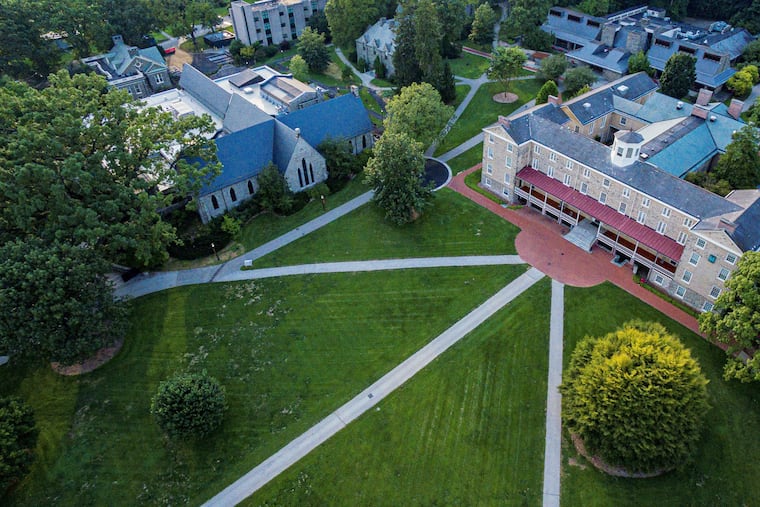As concern over student debt mounts, Haverford College touts debt relief effort for some graduates
Students who had loans as part of their financial aid package and are going into careers that serve the public good but are not high paying can get aid for up to three years under the program.

Arlene Casey graduated from Haverford College in May with $40,000 in debt and passion for a job not known for lucrative starting salaries.
“I have for a long time wanted to pursue a career as a teacher,” said Casey, 22, who is from the Bronx, “and I wanted to be able to do that well without taking on a lot of extra summer jobs or after schoolwork.”
A debt-relief program at Haverford is lending a hand.
Casey, who is teaching math at a private high school in Dobbs Ferry, N.Y., will receive $1,500 a year for up to three years toward loan payments. The money comes from a college endowment fund started to help students pursuing jobs that serve the public good but pay less than other careers.
“It’s not a solution for student debt in general, but it’s an incursion on that debt that we’re asking our students to take on,” said Wendy Raymond, who last summer became president of the 1,300-student liberal arts college.
Haverford announced the program in 2014, after the family foundation of alumnus Steven Jaharis donated $2 million for the effort. The Class of 2019 was the first eligible.
» READ MORE: How these Philly adults manage college debt of up to $229,000 | Debt Valley
Other colleges, often aided by donors, have been making similar strides to impact student debt. Billionaire Robert F. Smith last spring stunned the 2019 graduating class at Morehouse College when he announced he would wipe out the debt of the entire class, about $34 million. The college has since begun seeking donations to reduce the debt of future graduates.
Following others, Cornell’s medical school this fall announced a $160 million fund to erase debt for students who receive financial aid. Several law schools, including Pepperdine and Washington and Lee, have programs to help graduates in the public-interest sector.
Tufts University’s program, started in 2007, each year gives awards on average of $1,300 to nearly 400 students working in public sector or nonprofit jobs.
More recently, the University of Pittsburgh in 2018 announced Panthers Forward, which gives money to students for loan repayment shortly after graduation. The students are asked, but not required, to give back when they are able. So far, the fund has paid $735,564 to 150 students, with the average about $4,900.
And 150 more students have been selected to receive money after they graduate in May.
“Pitt is committed to growing this program so that we are on the forefront of solving the student debt crisis and encouraging alumni engagement throughout lifetimes," said Kris Davitt, senior vice chancellor for philanthropic and alumni engagement.
About a quarter of 2019 Haverford graduates had debt, with the average among those at $13,657, said Jess Lord, dean of admission and financial aid.
Jaharis, the 1982 alumnus, said he had become increasingly concerned about student debt, especially after Haverford in 2013 said it could no longer afford its “no loan” policy, under which it previously gave only financial aid grants to students that did not have to be repaid. In 2016, the school also announced it would have an annual cap on its financial aid budget.
“It’s corrosive in a way to have this money laying over you for years and perhaps cause you to regret some of the decisions you made about what you want to do with your education and your life,” said Jaharis, a family practice doctor in Chicago, who formerly served on Haverford’s governing board. “We really need to not only address it, but I think it would be a good idea for people who want to give money to their schools to find ways to trim the debt for students.”
Jaharis also made a donation to Tufts for a debt-relief fund for medical students going into family practice.
At Haverford, students seeking the relief must submit a proposal.
“The more impassioned they are, the more we want to support them,” said Ann Figueredo, vice president of institutional advancement.
» READ MORE: Penn State and Pa.’s public colleges are among the nation’s costliest — and are surprisingly empty | Debt Valley
Sixteen students applied this year; 12 got money. The fund covers only loan payments that were part of Haverford’s financial aid package. Haverford assigns loan amounts up to $12,000 over four years, depending on family income. (Families with income under $60,000 are not assigned loans, and at the other end, about half the student body pays the full tab, this year $73,468 for tuition, fees and room and board.)
Some families, including Casey’s, take out other loans. The amount colleges think families can afford without loans sometimes differs with what families think.
Casey said she is grateful for the money from Haverford.
“I felt very cared about by the school, that they were still looking out for my debt after I graduated,” she said.
Alissa Valentine, 22, who was raised in Michigan, also is receiving $1,500 this year and is working in a lab at Northeastern University in Boston that is looking at how early life stress and adversity can impact health later in life.
“I originally thought I was going to need to get a part-time job or work nights so I could make a significant difference on my student loan,” said Valentine, who majored in psychology. “When I heard [the debt relief program] was an option, I totally jumped on it.”
She said she and her parents have about $100,000 in loans from her education. The $1,500 from Haverford isn’t “a ton," she said, "but it’s a significant chunk of change at this time.”